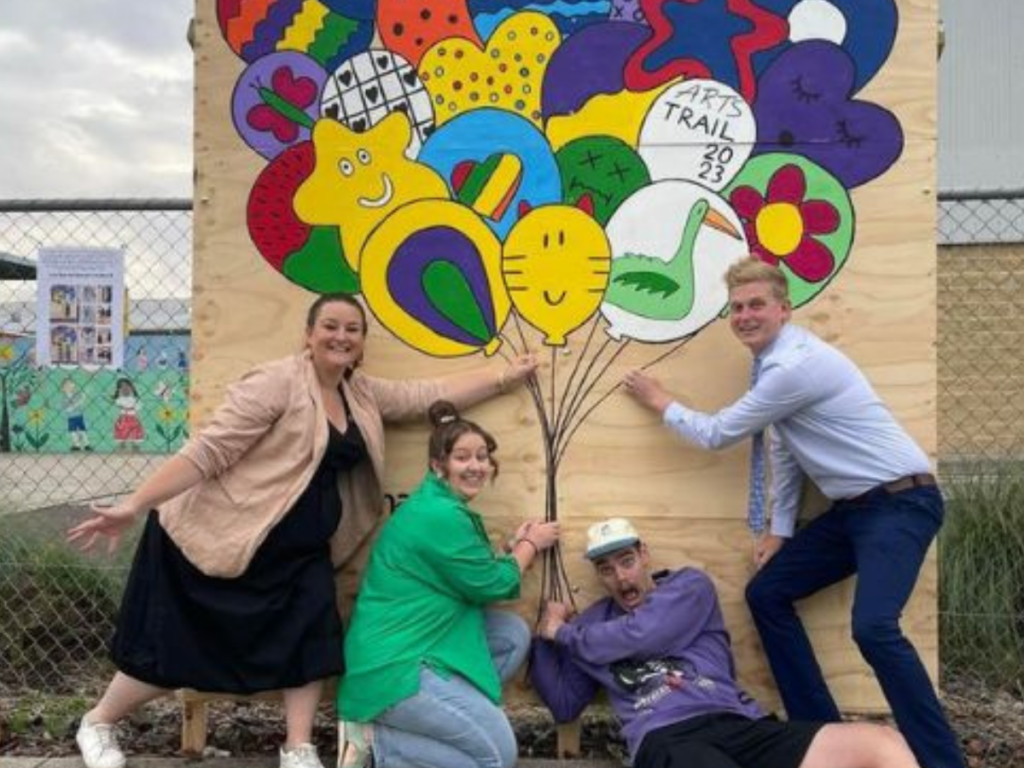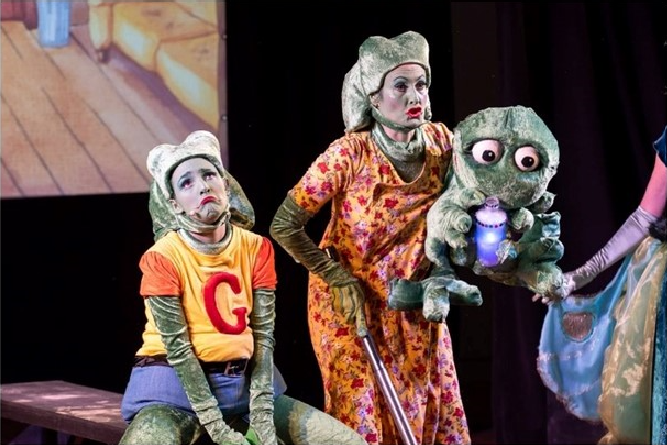Foundation for Rural & Regional Renewal (FRRR)
Located in the picturesque Colac-Otway Shire, Colac Makers’ Space provides a workspace for regional artists and undertakes community engagement with the arts. ReGenZ is a youth arts group run in partnership between Colac Makers’ Space and the Colac Youth Health Hub.

The group attracts significant numbers of young people to its activities, particularly LGBTQIA+ youth who see this group as a safe space in a community where their options for organised support are limited. Support for this cohort of youth is critical, given the rise in youth mental health issues since the onset of the COVID-19 pandemic. The group is one hundred percent volunteer-run, and like many other organisations, Creative Otways and the Colac Makers’ Space were facing significant hurdles post-COVID-19, with volunteer burnout colliding with increased need amongst youth.
To meet this increased need, and in the context of ongoing volunteer pressures, Colac Makers’ Space embarked on a new project. By hiring a professional artist as a mentor to teach skills in various art forms including drawing and sculpture, supporting them in life skills and accessing pathways to work in the arts field, the program provided deep engagement for the youth participants of ReGenZ, while providing some relief for the organisation’s volunteers. The program was run with support from local mental health services and culminated in an exhibition of the students’ work as part of the 2023 Colac Art Showcase and Exhibition. Flowing on from this, an annual exhibition program will help support the long-term sustainability of ReGenZ.
Lynne Richardson, Project Manager at Creative Otways (auspicing Colac Makers’ Space), highlighted the importance of the project to support local youth and volunteers:
“As a volunteer organisation we struggle with a limited number of volunteers and without this project, our youth Art group could have easily gone into remission as our volunteers struggled with many pressures … this project kept the youth group going and allowed us to deliver more projects which engaged more youth and gave much needed support to both our volunteers and our youth.“
With 15-20 youth attending the program each week, and more than 300 students engaged over the course of the program, Outside the SQUARE- ReGenZ was able to connect like-minded youth from Apollo Bay with those in Colac, allowing them an opportunity to be themselves, be creative and build their confidence. Impressively, 256 of the youth displayed their work at the Colac Art Showcase and Exhibition with other professional and emerging artists, and many were provided prizes of art vouchers to encourage continuation of their arts practice. Wider benefits were also felt by the project, with students from Studio 92, an all-ability arts venue, also participating in the exhibition with the support of the ReGenZ youth: inclusivity and kindness were on display as well as art works in Colac-Otway Shire!
Colac Makers’ Space was also able to capitalise on opportunities as they arose. The initial plan was for a well-known local artist, Reuban Whyte, to provide the mentoring role, however he took up a new position as the youth engagement officer at the Colac-Otway Council. The project was able to hire another local artist, Jodie McGill, to undertake the mentorship role while also engaging Reuban in an in-kind capacity through his Council role – meaning the youth had two mentors for the duration of the project – double the benefit for ReGenZ!
Auspiced by Creative Otways Incorporated, Colac Makers’ Space successfully applied to FRRR for a $10,000 SRC Rebuilding Regional Communities grant, funded by the Australian Government, to support this project.
The Cobargo Wellness Group formed following the bushfires that devastated the region on New Year’s Eve in the final hours of 2019. They exist to assist individuals and communities to thrive after crisis with emotional and physical support through creative projects, groups and events.
Ongoing impacts on local communities following bushfires, COVID 19 and floods meant an increased demand for their popular programs ‘Thriving After Crisis’, which is being developed into an online course, and ‘Ginger the Frog’, a theatre production for children and the young at heart. In response Cobargo Wellness Group sought to further enhance these programs to reach more local parents and children.
Grant funds of $10,000 from FRRR’s Investing in not-for-profit capacity program were used to bring in more hands and expertise to help with project planning, website design, and create a documentary of the Ginger the Frog production and journey. Ginger the Frog then toured three LGA’s – Coffs Harbour, Nambucca Shire and Hawkesbury Shire to great reviews.
‘Children wanted to go back and see the show straight after they’d just seen it, parents brought their friends for another session, the kids went crazy when it was time to join in with the activities and dancing’.
The Thriving After Crisis program was promoted alongside Ginger the Frog events to provide another support for families dealing with trauma. A future goal is to build on the scale of the show, with ambitions to tour it around the country and even internationally.
Around 800 children, parents and teachers were able to enjoy fun filled shows which included activities, dancing, laughter and wellness techniques. Cobargo Wellness Group reported it was a great opportunity for community connection, warmth, laughter, song and dance, all of which the group believes are the best way forward when recovering from a crisis. A further benefit to local residents is they will receive a digital version of the Ginger the Frog program for free along with access to the Thriving After Crisis program.
Upon reflecting on the success of the project, which involved hard work and long hours to bring it all together, Cobargo Wellness Group told us “joyous occasions create great memories, open the heart, and build connection and courage to work together as a community.”
“I’m also very proud of the fact that in my own community, organisations and the general community trust us now to offer quality programs and events.”
Calls for embedding creative projects in disaster recovery
A new report released today has validated the long-term and multi-pronged impact of creative projects in the recovery of rural communities following disaster events.

The Impacts of Creative Recovery report confirmed that arts projects have a unique ability to build long-lasting community resilience, wellbeing and local capacity for disaster preparedness, response and recovery. It also highlights that creative recovery programs have the capacity to mitigate disaster impacts, as well as the disempowerment that so often results from the stresses and strains of disasters.
The study, undertaken by the Creative Recovery Network, involved reviewing five diverse arts-led projects funded by FRRR to support recovery following different disaster events. Researchers Elouise Bagnara and Bronwyn Ward explored project outcomes across four key areas: social capital and connection; revitalisation and placemaking; acceptance and growth; identity and belonging.
The evaluation recommends new approaches to provide ongoing support for creative recovery programs; to embed creative recovery processes into policy, which is integrated into wider disaster management arrangements; and investment in local creative economies to provide ongoing participation and employment in the arts.
FRRR’s Disaster Resilience and Recovery Lead, Nina O’Brien, said that FRRR has seen the impacts that projects have in the medium-term but this was a chance to check back in and look at the longer-term legacy of each of these projects.
“The evaluation showed each project has had a marked impact on lasting social capital and connection, leaving a legacy of enriched community and social connection, while permanently strengthening both creative practice and disaster management processes.
“It was inspiring to see the influence they’d also had on local placemaking, helping create a stronger sense of identity, particularly informing how the community was seen by others. The report also found that the projects led to mentorship and educational opportunities that have influenced both the prosperity of the local community and the quality of life of those living in affected communities.
“But some of the strongest benefits were around mental health, helping people to understand and shape their world and respond to the disaster event. The projects also seem to have increased the understanding of mental health and led to improved wellbeing practices and resources, which is so important for the long-term health of these communities,” Ms O’Brien said.
Creative Recovery Network Executive Officer, Scotia Monkivitch, said in many ways, the report confirmed what the sector has known for some time, but it adds impetus to the call for further funding and embedding such initiatives into disaster management processes.
“We know that arts and culture play an integral role in building social cohesion, connectedness and strength for a hopeful future. This report contributes to the growing body of research that clarifies the many benefits arts-based practices can bring to disaster impacted communities through supporting opportunities for respite and joy, providing spaces for gathering and connection and improving mental health outcomes through engagement in creative processes.
“Our hope is that this report will support the ongoing development of policy frameworks and funding opportunities to embed the arts in programs that support communities through the disaster experience and build capacity for future challenges,” Ms Monkivitch.
Impacts of Creative Recovery was jointly commissioned by Creative Recovery Network and the Foundation for Rural & Regional Renewal. The report was researched by Elouise Bagnara and Bronwyn Ward and authored by Elouise Bagnara.




